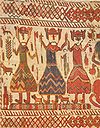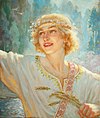Blostlandic Paganism: Difference between revisions
No edit summary |
No edit summary |
||
| (9 intermediate revisions by the same user not shown) | |||
| Line 1: | Line 1: | ||
{{WIP}} | {{WIP}} | ||
'''Blostlandic Paganism''', or '''North Sea Paganism''' (Blostlandic: ''Vanǫ́trú'': "Belief in the Gods"), is a branch of old Weranic Paganism that arose during the times of the ancient Blostlandic and North Sea peoples in the area of the modern day North Euclean Archipelago in Kylaris. It was previously the dominant religion on the Island of Nordavia before Blostlandic Sotirianitization began in | '''Blostlandic Paganism''', or '''North Sea Paganism''' ({{wpl|Swedish language|Blostlandic}}: ''Vanǫ́trú'': "Belief in the Gods"), is a branch of old Weranic Paganism that arose during the times of the ancient Blostlandic and North Sea peoples in the area of the modern day North Euclean Archipelago in Kylaris. It was previously the dominant religion on the Island of Nordavia before Blostlandic Sotirianitization began in 1402 AD. | ||
[[File:Midvinterblot (Carl Larsson) - Nationalmuseum - edited.jpg| | [[File:Midvinterblot (Carl Larsson) - Nationalmuseum - edited.jpg|center|thumb|450px|Temple of Rud]] | ||
A polytheistic faith with many deities | A polytheistic faith with many deities, the deities were split into two groups, the Vanǫ́sir and the Vættir. The Vanǫ́sir who are the Gods and the Vættir who are more common spirits found everywhere. The two most important Vanǫ́sir are Friðill and Elskr who are said to be responsible for creating Kylaris in Blostlandic mythology. The world in Blostlandic Paganism was full of many Vættir who were created by Vanǫ́sir the including those of the Sea, Air, Fire, Ice, and Earth. The mythology of Blostlandic Paganism also revolves around the idea of the Next Shore which is a land beyond Vanǫ́garðr and said to be in some accounts where they will be reborn as new deities to experience new lives. | ||
Spread mostly through oral tradition Blostlandic Paganism focused mostly on rituals with an emphasis on using rituals as way to please the chief Gods or lower spirits to aid you in a task. Usually unorganized there was no central location for one to perform rituals and it was just done in the early morning before ones day. Later in history temples such as the Temple of Rud would be created by some of the nobility on the island leading to more centralized worship in certain areas, this development would not last however as the faith would purged from the island not long after. | |||
After Sotirianitization Paganism was scrubbed from the Blostland almost completely though monks and mythology kept it in Blostlandic culture till the turn of the century. After the failure of colonization and the general decline of the Kingdom of Blostland romantic literary movements centered around the past would start to revie parts of Blostlandic Paganism with major pieces of art such as the painting of the Temple of Rud and the book, Old Bones doing much of the heavy lifting in returning Blostlandic Paganism back to the mainstream. | |||
=Common Features= | =Common Features= | ||
Latest revision as of 22:12, 22 February 2024
This article is incomplete because it is pending further input from participants, or it is a work-in-progress by one author. Please comment on this article's talk page to share your input, comments and questions. Note: To contribute to this article, you may need to seek help from the author(s) of this page. |
Blostlandic Paganism, or North Sea Paganism (Blostlandic: Vanǫ́trú: "Belief in the Gods"), is a branch of old Weranic Paganism that arose during the times of the ancient Blostlandic and North Sea peoples in the area of the modern day North Euclean Archipelago in Kylaris. It was previously the dominant religion on the Island of Nordavia before Blostlandic Sotirianitization began in 1402 AD.
A polytheistic faith with many deities, the deities were split into two groups, the Vanǫ́sir and the Vættir. The Vanǫ́sir who are the Gods and the Vættir who are more common spirits found everywhere. The two most important Vanǫ́sir are Friðill and Elskr who are said to be responsible for creating Kylaris in Blostlandic mythology. The world in Blostlandic Paganism was full of many Vættir who were created by Vanǫ́sir the including those of the Sea, Air, Fire, Ice, and Earth. The mythology of Blostlandic Paganism also revolves around the idea of the Next Shore which is a land beyond Vanǫ́garðr and said to be in some accounts where they will be reborn as new deities to experience new lives.
Spread mostly through oral tradition Blostlandic Paganism focused mostly on rituals with an emphasis on using rituals as way to please the chief Gods or lower spirits to aid you in a task. Usually unorganized there was no central location for one to perform rituals and it was just done in the early morning before ones day. Later in history temples such as the Temple of Rud would be created by some of the nobility on the island leading to more centralized worship in certain areas, this development would not last however as the faith would purged from the island not long after.
After Sotirianitization Paganism was scrubbed from the Blostland almost completely though monks and mythology kept it in Blostlandic culture till the turn of the century. After the failure of colonization and the general decline of the Kingdom of Blostland romantic literary movements centered around the past would start to revie parts of Blostlandic Paganism with major pieces of art such as the painting of the Temple of Rud and the book, Old Bones doing much of the heavy lifting in returning Blostlandic Paganism back to the mainstream.
Common Features
Terms
| Name | Image | Details |
|---|---|---|
| Vanǫ́sir | The Gods of the faith. | |
| Vættir | Spirits that exist in all things. | |
| Vanǫ́garðr | The home of the Gods. | |
| Himnarvangr | The afterlife. |
Deities
| Name | Image | Other names | Details |
|---|---|---|---|
| Friðill | The Lover | Friðill is the Goddess of Fertility, the Sky/Space, and Love. | |
| Elskr | The Beloved | Elskr is the God of Harvest, the Earth, and Family. | |
| Valfǫðr | Father of the Slain | Valfǫðr is the God of the dead, second son of Friðill, and brings the dead to the afterlife where he cares over them. | |
| Yggr | The Terrible One | Yggr is the God of War, third son of Friðill, started the Human-Vættir War; the cause of all wars in human history. |







